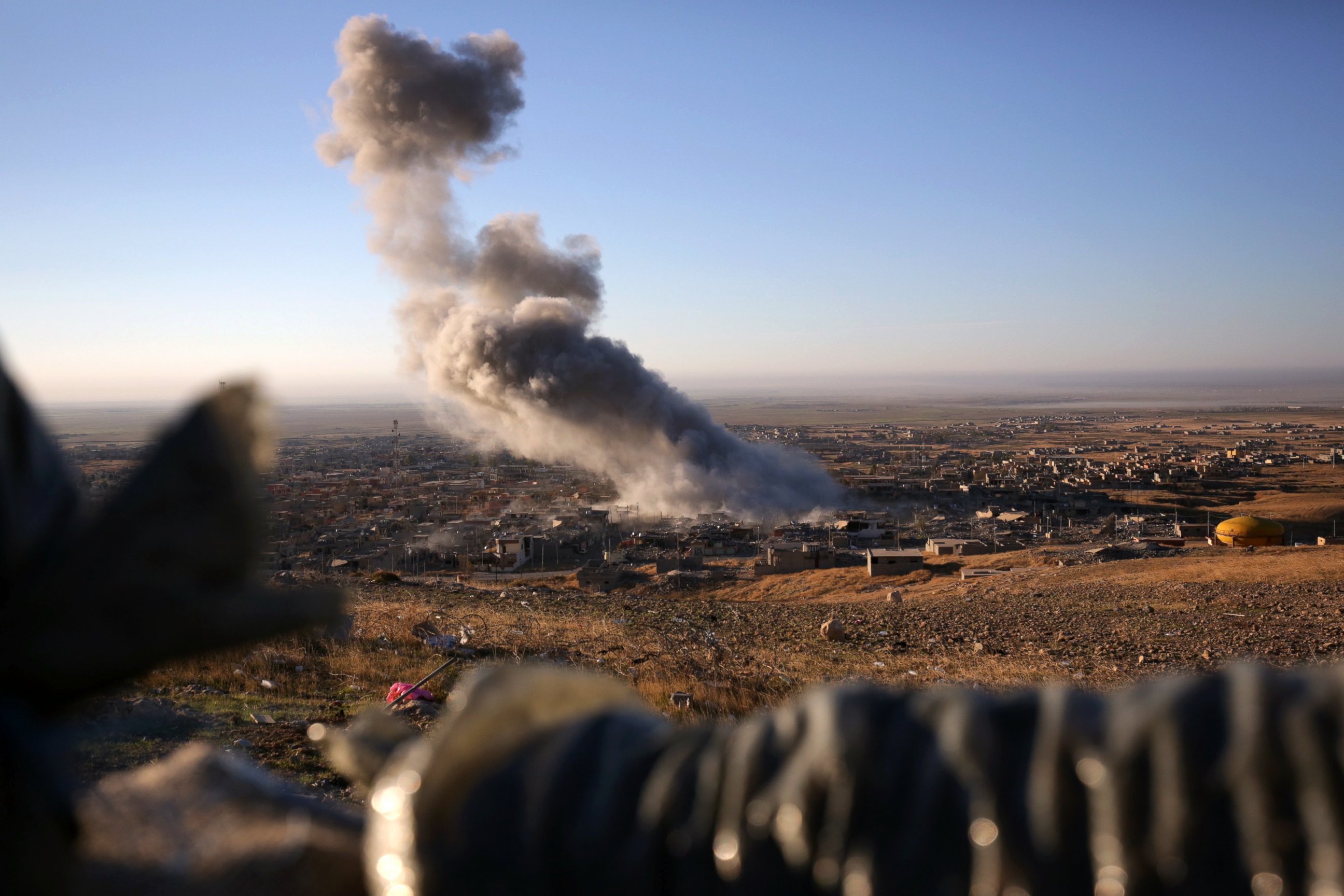US-Backed Kurdish Offensive Pushes to Retake Sinjar From ISIS
Kurds claim to have taken part of a key highway.
— -- Hours after it began, a large Kurdish offensive has retaken from ISIS a section of a key highway in northwestern Iraq that has served as a main supply route between ISIS forces in Syria and Iraq. More than 7,500 Kurdish fighters began their assault on the ISIS held town of Sinjar early this morning after U.S. aircraft conducted two dozen airstrikes on ISIS targets in support of the operation.
A statement released by the Kurdish Regional Security Council claimed that Peshmerga fighters had captured Highway 47, a strategic road near the town of Sinjar that is a main supply route between the ISIS de facto capital of Raqqa in Syria and the Iraqi city of Mosul.
The town of Sinjar sits on the southern face of Mount Sinjar, which was the focus of a humanitarian crisis in August 2014 when thousands of ethnic Yazidis fled up the mountain to escape what they saw as certain death at the hands of ISIS fighters. The plight of the Yazidis trapped on the mountain led to U.S. airdrops of humanitarian aid that precipitated the air strike campaign against ISIS.
Though the Yazidis were eventually able to flee the mountain on their own, the town remained in ISIS control, enabling the terror group's control of Highway 47 as a main supply route for weapons, fighters and illicit oil.
Iraqi state television says Kurdish fighters have already reached the mayor's office in the heart of the town.
An earlier statement by the Kurdish Regional Security Council said "Operation Free Sinjar" included up to 7,500 peshmerga fighters moving in on the town "from three fronts to cordon off Sinjar City."
It said the offensive's objective was to "take control of ISIL's strategic supply routes, and establish a significant buffer zone to protect the city and its inhabitants from incoming artillery."
ISIL is another name used to describe ISIS.

To support the ground offensive, coalition aircraft conducted 24 airstrikes that a coalition statement said struck nine ISIS tactical units, staging areas, and destroyed 27 fighting positions, and an assortment of weapons and bunker areas. The airstrikes were part of more than 250 conducted over the past month in northern Iraq.
"The Iraqi Security Forces, including the Peshmerga, continue to put pressure on Da'ish across Iraq, including in Ramadi, Bayji, and now Sinjar and along Highway 47," said Col. Christopher C. Garver, Combined Joint Task Force - Operation Inherent Resolve Public Affairs Officer. "This operation will degrade Da'ish's resupply efforts, disrupt funding to the terrorist group's operations, stem the flow of Da'ish fighters into Iraq, and further isolate Mosul from Ar Raqqah."
Da'ish is the Arabic acronym used to describe ISIS.
A U.S. military official told ABC News that it is estimated that there are several hundred ISIS fighters in Sinjar.
Despite the Kurds numerical advantage, the official anticipated "a tough fight" given ISIS's well-prepared defenses in Sinjar "and we expect that ISIL will defend fiercely."
That said, the official predicted it could take two to four days to secure the town and another week to finalize clearing operations.
Pentagon Press Secretary Peter Cook confirmed to reporters that in addition to U.S. advisers at Kurdish headquarters there were also some U.S. Special Operations advisers alongside Kurdish forces on Mount Sinjar, though not on the front lines.
"There are some advisers who are on Sinjar mountain, assisting in the selection of airstrike targets," Cook said. "They are not acting as JTACs, but they are working directly with Peshmerga forces in determining exactly where the most effective airstrikes would be conducted.”
JTACs are Joint Terminal Air Controllers who serve on the front lines and directly communicate with coalition aircraft to call in airstrikes. Placing them alongside Iraqi troops would go against the Obama administration's policy of not having American troops in Iraq serve in a combat role. American military commanders have so far not seen the need for a JTAC presence noting the long term success of a workaround system where information from the battlefield supplied by Iraqi forces, Kurdish forces and American advisers is sent to a joint operations center that determines airstrike targeting.
The Kurdish offensive opens up a new pressure point against ISIS in Iraq where Iraqi security forces have made slow progress against ISIS in months-long offensives in Bayji and Ramadi.
A planned Iraqi offensive to retake Mosul earlier this year was delayed after ISIS captured Ramadi in May, shifting the Iraqi military's focus to retaking the city in western Iraq.
The Iraqi offensive to retake Ramadi began in mid-July but moved slowly as Iraqi troops pushing into the city encountered tough ISIS defenses, particularly roadside bombs and mines planted on the approaches to the city.
Maj. Gen. Richard Clarke, the top U.S. military commander in Iraq, told reporters earlier this week that Iraqi troops had pushed to the banks of the western bank of the Euphrates in Ramadi. He predicted they would soon press into the city's downtown area where it is believed there are still hundreds of ISIS forces.
Clarke said the Iraqi offensive and coalition airstrikes have "destroyed" thousands of ISIS fighters in the city. Iraqi forces have also taken significant casualties as 250 Iraqi soldiers have been killed and about 800 have been wounded.
Looking forward to plans to retake Mosul, Clarke said a new joint operations center staffed by Iraqi and Kurdish officers has been established in northern Iraq with the express purpose of planning for a Mosul offensive.




